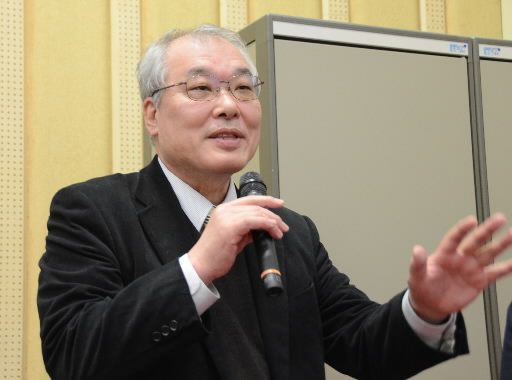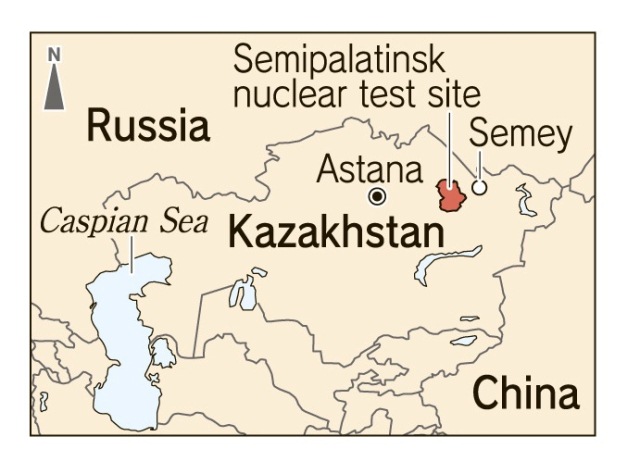Hiroshima professor shares research on radiation exposure involving Semipalatinsk nuclear test site
Feb. 12, 2013
by Junji Akechi, Staff Writer
Masaharu Hoshi, 65, a professor emeritus at Hiroshima University and a specialist in radiation biology and physics, shared his research findings in a lecture at Shimane University Medical School, located in the city of Izumo, Shimane Prefecture. Professor Hoshi has been studying the radiation exposure suffered by people in Kazakhstan, where the Semipalatinsk nuclear test site, the largest test site maintained by the former Soviet Union, was once located. He discussed such topics as his findings over the many years he has pursued this research and the difficulties involving risk assessment for radiation exposure.
In 1993, Professor Hoshi learned about conditions in Kazakhstan from a Kazakh researcher who visited Hiroshima University’s Research Institute for Radiation Biology and Medicine (RIRBM), located in Minami Ward, Hiroshima, and embarked on his research in 1994. “After hearing about the situation,” he said, “I realized that this was a serious matter.” Since that time, Professor Hoshi has continued his efforts to estimate the doses of radiation exposure suffered by local residents by investigating the levels of radiation lingering in soil and brick.
His motivation for continuing to study the site is linked to the limitations of the current risk assessment for exposure to radiation.
The current radiation protection standard, used in and out of Japan, is a reflection of the risk assessment based on the dosimetry system known as DS02, which estimates the radiation doses of A-bomb survivors of Hiroshima and Nagasaki. But, as Professor Hoshi pointed out in his lecture, “It’s believed that the risks are different between the instantaneous exposure to radiation caused by the atomic bombing and the low-dose exposure to radiation over a long period of time.” He also touched on the difficulty of estimating internal exposure, which occurs when radioactive substances find their way into the body.
In the more than 10 years he has pursued his on-site studies, Professor Hoshi has joined hands with researchers in Kazakhstan to analyze samples of human teeth, thyroids, chromosomes, and other elements of the human body. He explained, “I judged that it would be difficult, given the sensitive level of the doses, to derive accurate estimates relying on only one method.”
After checking a range of estimated results, the scientists have come to the conclusion that the radiation dose in a village located 110 kilometers from the test site was about 500 milligray. Based on this figure, they have established a system for estimating the level of radiation that residents were exposed to by analyzing the amount of radiation still found in the soil. Describing this achievement, Professor Hoshi said, “With this system, we are now also able to estimate radiation doses at other locations.”
But, he added, “With regard to the effects of radiation, there are many factors we have not yet clarified,” and so the final risk assessment has not been completed.
Professor Hoshi also referred to the accident at the Fukushima No. 1 (Daiichi) nuclear power plant, stressing, “As long as we are unsure of its impact, recording accurate data from research on the radiation exposure is vital, rather than engaging in debate over the potential dangers.”
The lecture was held on January 28, the day Shimane University and Semey State Medical University, located in Semey (formerly Semipalatinsk), Kazakhstan concluded an exchange agreement. About 150 people, including students and faculty members, attended Professor Hoshi’s lecture.
Profile
Masaru Hoshi
Born in the city of Miyazaki, Miyazaki Prefecture in 1948. After serving as a research assistant and an assistant professor at the Hiroshima University Graduate School, he assumed the post of professor at the Research Institute for Radiation Biology and Medicine (RIRBM). In March 2012, he resigned from that position and currently serves as a professor emeritus at Hiroshima University.
Keywords
Radiation sufferers in Kazakhstan
The Semipalatinsk nuclear test site, covering an area of roughly 18,500 square kilometers in size, equal to the size of Shikoku Island in Japan, was located in Kazakhstan, making it the largest nuclear test site administered by the former Soviet Union. Between 1949 and 1989, over 450 nuclear tests were carried out there. Among them, more than 100 nuclear tests were conducted in the air and on the ground, spreading radioactive substances over wide areas and resulting in serious damage to the health of local residents, including a number of abnormal births. Even since its closure in 1991, many still continue to suffer from heart ailments, blood pressure-related diseases, lung cancer, and other illnesses. The Kazakh government estimates that as many as 1.5 million people have been affected by the nuclear tests.
(Originally published on February 4, 2013)
Masaharu Hoshi, 65, a professor emeritus at Hiroshima University and a specialist in radiation biology and physics, shared his research findings in a lecture at Shimane University Medical School, located in the city of Izumo, Shimane Prefecture. Professor Hoshi has been studying the radiation exposure suffered by people in Kazakhstan, where the Semipalatinsk nuclear test site, the largest test site maintained by the former Soviet Union, was once located. He discussed such topics as his findings over the many years he has pursued this research and the difficulties involving risk assessment for radiation exposure.
In 1993, Professor Hoshi learned about conditions in Kazakhstan from a Kazakh researcher who visited Hiroshima University’s Research Institute for Radiation Biology and Medicine (RIRBM), located in Minami Ward, Hiroshima, and embarked on his research in 1994. “After hearing about the situation,” he said, “I realized that this was a serious matter.” Since that time, Professor Hoshi has continued his efforts to estimate the doses of radiation exposure suffered by local residents by investigating the levels of radiation lingering in soil and brick.
His motivation for continuing to study the site is linked to the limitations of the current risk assessment for exposure to radiation.
The current radiation protection standard, used in and out of Japan, is a reflection of the risk assessment based on the dosimetry system known as DS02, which estimates the radiation doses of A-bomb survivors of Hiroshima and Nagasaki. But, as Professor Hoshi pointed out in his lecture, “It’s believed that the risks are different between the instantaneous exposure to radiation caused by the atomic bombing and the low-dose exposure to radiation over a long period of time.” He also touched on the difficulty of estimating internal exposure, which occurs when radioactive substances find their way into the body.
In the more than 10 years he has pursued his on-site studies, Professor Hoshi has joined hands with researchers in Kazakhstan to analyze samples of human teeth, thyroids, chromosomes, and other elements of the human body. He explained, “I judged that it would be difficult, given the sensitive level of the doses, to derive accurate estimates relying on only one method.”
After checking a range of estimated results, the scientists have come to the conclusion that the radiation dose in a village located 110 kilometers from the test site was about 500 milligray. Based on this figure, they have established a system for estimating the level of radiation that residents were exposed to by analyzing the amount of radiation still found in the soil. Describing this achievement, Professor Hoshi said, “With this system, we are now also able to estimate radiation doses at other locations.”
But, he added, “With regard to the effects of radiation, there are many factors we have not yet clarified,” and so the final risk assessment has not been completed.
Professor Hoshi also referred to the accident at the Fukushima No. 1 (Daiichi) nuclear power plant, stressing, “As long as we are unsure of its impact, recording accurate data from research on the radiation exposure is vital, rather than engaging in debate over the potential dangers.”
The lecture was held on January 28, the day Shimane University and Semey State Medical University, located in Semey (formerly Semipalatinsk), Kazakhstan concluded an exchange agreement. About 150 people, including students and faculty members, attended Professor Hoshi’s lecture.
Profile
Masaru Hoshi
Born in the city of Miyazaki, Miyazaki Prefecture in 1948. After serving as a research assistant and an assistant professor at the Hiroshima University Graduate School, he assumed the post of professor at the Research Institute for Radiation Biology and Medicine (RIRBM). In March 2012, he resigned from that position and currently serves as a professor emeritus at Hiroshima University.
Keywords
Radiation sufferers in Kazakhstan
The Semipalatinsk nuclear test site, covering an area of roughly 18,500 square kilometers in size, equal to the size of Shikoku Island in Japan, was located in Kazakhstan, making it the largest nuclear test site administered by the former Soviet Union. Between 1949 and 1989, over 450 nuclear tests were carried out there. Among them, more than 100 nuclear tests were conducted in the air and on the ground, spreading radioactive substances over wide areas and resulting in serious damage to the health of local residents, including a number of abnormal births. Even since its closure in 1991, many still continue to suffer from heart ailments, blood pressure-related diseases, lung cancer, and other illnesses. The Kazakh government estimates that as many as 1.5 million people have been affected by the nuclear tests.
(Originally published on February 4, 2013)









